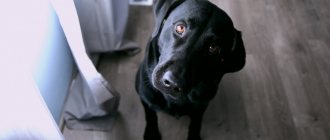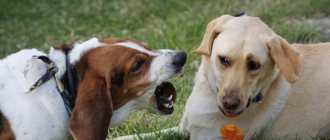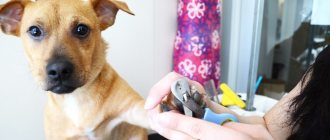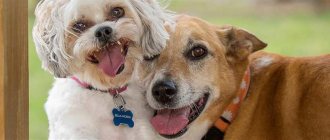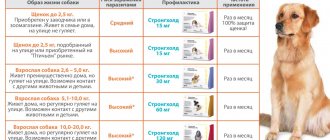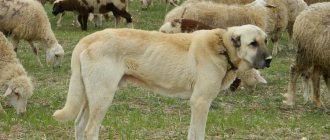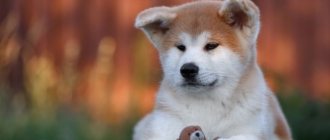The fear of a protective pet must be stopped. Find out why the dog is afraid of its relatives and people from the article.
We associate a dog with reliable security and protection. Large breed dogs are taken into the yard or apartment for this very purpose, and even small “bells” - Chihuahuas or Yorkies - are expected to at least notify of the appearance of strangers with a ringing bark. But it happens that an animal, instead of fulfilling its intended role, simply hides from others - this applies to both fellow dogs and people. Why is your pet like this?
Causes of fear
In all dogs, the process of socialization must begin at an early age, when your dog is still a small puppy, this requires training to interact with other pets and people outside the home. Even those dogs that have had various contacts can show fear of members of their own species. The main reasons for this are :
- Injury,
- premature weaning,
- insufficient socialization,
- overindulgence.
Why is a pet afraid of its own kind?
Most dog owners are not very familiar with dog psychology. Not only do they not know how to help their pet overcome their own fear, but they also unwittingly aggravate the condition of their four-legged friend by encouraging such behavior.
To solve the problem, experts recommend finding out what triggered the development of the phobia.
Insufficient socialization
This is the most common drawback, the culprit of which is the owner himself. Experienced dog handlers and breeders confirm that if a puppy, until the age of 5-6 months, did not go for walks outside of his yard or apartment, did not visit public places and did not meet other people and animals, then in most cases he develops some kind of phobia.
But in this case, it is not necessary that the condition will manifest itself precisely in the form of fear of other dogs. A pet may be afraid of cars, people, animals, or foreign sounds. The risk of escape in unsocialized pets is much higher. Sooner or later, such a dog ends up on the street and is unable to return home on his own. It is worth protecting your timid pet and taking him for walks only on a leash. If you do not adhere to this rule, you may lose your dog forever.
Low levels of socialization can also be caused by the puppy being taken away from the bitch too early. It is advisable that the offspring stay with their mother for up to 2-3 months. During this period, babies manage to gain their first knowledge about the world around them, they learn to interact with their mother and brothers, and she also gives important educational lessons. In addition, looking at the behavior of the bitch, puppies begin to understand what a person means to a dog, what place he occupies in her life.
Artificial puppies are deprived of this school; they learn their first skills from people. And the person feeding the baby should not miss the moment; it is important to develop the pet’s personality and support it:
- the puppy must learn to play, both to win and to lose;
- he needs to be able to compete for food.
Experienced mental trauma
The second most common cause of phobias in animals. A similar phenomenon is often encountered by owners who take an adult pet from a zoo shelter or from the street. As soon as the dog finds itself in a new home, it goes through an adaptation period, and how long it will take to recover is unknown. During adaptation, the dog can be scared of everything, even the owner.
Hereditary tendency
A rather rare reason that affects a pet’s fear of dogs. By nature, dogs are sociable, and if they are afraid of someone, they will try to avoid contact. When a dog comes face to face with a frightening object, it can take a defensive position, and if the opponent wins in size and power, then it can run away.
Genetic predisposition can be assumed, but it is not guaranteed. Typically, signs of cowardice appear in puppies by the age of 4-8 weeks. Such babies avoid playing with brothers and sisters, are frightened by noise, and grow somewhat slower than others, since they do not compete for food.
Fright experienced as a puppy
It is impossible to predict whether the fear experienced by the puppy will come back to haunt you in the future. The cause of severe stress is often a visit to the veterinary clinic, careless handling, inappropriate behavior of the bitch, etc.
Premature weaning
After birth, the period when puppies remain with their mother is critical to their continued development as healthy adults. Besides the nutrients provided by breast milk, the relationship with its mother and brothers is the first socialization process that every puppy goes through .
The puppy can be weaned after the eighth week of life, although ideally this takes three months. Otherwise, there is a risk of behavioral disorders such as uncertainty, fear and aggressiveness.
Aggression and breed affiliation
Some dog breeds are believed to be more prone to interspecies aggression. Experienced owners and dog handlers say that there are no naturally aggressive dogs.
When it comes to interspecific aggression, the exception is dogs of fighting breeds, which were bred for baiting and fighting with their relatives. However, the reputation of fighting breeds has, by and large, been ruined by the media; statistically, the most dangerous are service dogs.
It is important to understand that almost all service and fighting dogs have impressive dimensions. Don't get a puppy unless you are confident that you can handle the pressure of an adult pet. Even the most well-mannered dogs sometimes get angry, and in such a situation the outcome depends only on the physical strength of the owner.
Regardless of the choice of breed, you need to take a responsible approach to education. If you do not have experience in training service, fighting or any other “difficult” dogs, it is better to immediately seek help and enroll your pet in special courses.
When living in the city, in addition to the general training course, it is advisable for your pet to complete a city dog course, which allows you to gain skills in behavior in society, near the roadway and in crowded places.
Signs of fear in dogs
Understanding your dog's body language will help you train a healthy four-legged dog when he is relaxed, nervous or intimidated. Look for the following signs that indicate fear :
- the dog is watching another dog, but slightly bows its head,
- squeezes the tail and hides it between the hind legs,
- pulls back the body, drawing an arc with the spine,
- it appears as if your dog is paralyzed,
- puts ears to head
- growls or tries to run away,
- involuntary urination.
Proper owner behavior
As already mentioned, ignorance of the owner can provoke the development of cowardice in the pet. What mistakes should you avoid so that your puppy does not grow up fearful? First of all, when a dog gets scared, you cannot calm him down and feel sorry for him. Of course, this is a completely normal human reaction to such a situation.
The dog views it as an encouragement for cowardly behavior. A panic attack has occurred, which means it will be followed by affection and treats. The pet understands one thing - its fear is a normal state, and the owner is pleased with this behavior.
Over time, this habit takes root, and it can be extremely difficult to rid your dog of it. To wean him from being afraid, the owner should change his attitude towards such situations. It is important to understand that by pitying and protecting the dog, it is doing a disservice. Of course, we are not talking about threats of physical injury to the animal.
A frightened dog should be distracted, and to do this, any dog breeder has several methods in his arsenal:
- you can give your pet a few simple commands that will not cause him any difficulties;
- offer to play or give him his favorite toy.
The owner should behave calmly, as if nothing had happened, and try to switch the animal’s attention from the object that causes fear to something more pleasant. In addition, dogs can adopt the habits of other four-legged animals. For example, if his playmate is afraid of vehicles, he may also become afraid of them.
How to deal with fear
When your dog is causing anxiety, you should take the necessary decisions to ensure that your friend does not suffer from anxiety, only then will he be a healthy and happy companion.
If you have asked yourself “what should I do if my dog is afraid of other dogs?” then apply these recommendations :
- Walk your dog - You may already be doing this, but you'll be avoiding areas where other dogs play. To start socializing, start walking near neighborhoods or parks, but away from dogs. Repeat the operation daily, observing your dog's reactions in front of other dogs. As the sessions progress, you will be able to get closer to the dogs so that your friend feels safe.
- Practice Agility – Agility clubs are overflowing with dogs, making it a great environment to meet pets of all sizes and breeds. Don't force him to socialize, let him get close to dogs that inspire confidence until he feels safe around others.
- Counterconditioning – Instead of petting and calming your dog when he shows signs of fear of other animals, distract him and play with him. This way he will correlate the activities he enjoys with the presence of other dogs.
- Use positive reinforcement - when your four-legged friend takes a step towards another dog, pamper him for it with gentle words or treats. This will reinforce the idea that spending time with friends means something good.
Getting your dog to socialize with other dogs is a process that takes time, consistency, and patience. He will be very unsure for the first few days, don't be discouraged if he refuses to come over and never force him to do so.
If you don't have experience helping you overcome your fear, it is recommended that you seek help from a professional dog trainer.
general information
Just some two decades ago, dog cowardice was considered an unforgivable, serious vice. The exception was dogs of some decorative breeds, but not all. Unfortunately, the situation is aggravated by the fact that dog breeding today has been elevated to a business.
Many breeders, in pursuit of profit, turn a blind eye to some of the shortcomings of the individuals involved in breeding. As a result, people spend substantial amounts of money on purchasing a purebred service dog, and after just a couple of months they notice that their pet has mental problems.
Don’t forget about one nuance - some disorders only appear when the pet grows up. In this case, training turns out to be problematic, and during work the owner is faced with the fact that the dog cannot control himself, is easily excited, enters into conflicts with other dogs, or is terrified of them.
Experts identify two reasons for dogs’ fear of their own kind. Either the dog is not properly socialized and simply does not know how to behave around other dogs, or he is not confident in his own abilities and feels that in the event of a fight he will not be able to protect himself.
In such a case, the dog is unsociable, has a tendency to run away, and is irritable after walking. During an intense attack of phobia, he begins to fall to the ground and lie motionless, defecating uncontrollably when another dog approaches him.
Fear of the street is another problem that is further reinforced if the pet is afraid of other animals. The cause of fear is insufficient socialization, that is, the four-legged animal was not taught how to behave in the outside world, to react correctly to people, vehicles, and other animals. He is afraid of everything that he does not understand, walks become torture for both the dog and the owner. Usually the dog, as soon as it does its business, runs away to the house or pulls the owner there.
Dogs with such an unstable psyche are not confident in themselves; they can evaluate any sound or action of passers-by incorrectly. Therefore, in some cases, dogs become dangerous to others, since it is almost impossible to predict their reaction.
Control is necessary
The owner’s task is to keep the situation under control during walks. And it doesn’t matter whether the dog has grown up or is a very small puppy. There may always be a pack of stray dogs or an aggressive neighbor nearby, and meeting with them sometimes ends in a fight and injuries.
The stronger should not be allowed to offend the weaker. Not all pets are noble and allow you to occasionally bite the ear of a weaker one or quietly click their teeth to intimidate. Such situations need to be noticed and stopped.
If during walks the dog begins to be offended, it is better to change the route so that your beloved dog does not turn into a depressed, unhappy creature who is accustomed to obeying and hiding cowardly.
But this can also happen. A growing dog, who was afraid of older and stronger ones, at the next meeting may unexpectedly feel his strength and take it out on the offender. And, having won the fight, show aggression in the future towards others, or simply get rid of your complexes forever.
how to stop a puppy from biting and grabbing legs
General information
Even 20-30 years ago, the cowardice of dogs was talked about quite clearly - this is an unforgivable vice. Exceptions were made for lap dogs, and even then, not always. Modern business, built by people on the thoughtless breeding of service breeds, gives only the first fruits. More and more owners are spending a lot of money on purchasing purebred dogs, and after a few months, it is discovered that the puppy has mental problems.
The difficulty is that problems can be detected even when the dog is an adult . Difficulties arise during training or working in real conditions; four-legged animals grow up excitable, have poor self-control under stress, fight with relatives (including those of the opposite sex), can pose a danger to people, etc.
The owner needs to understand that fear of other dogs can have two root causes. True fear of dogs - that is, your pet does not know how to communicate with its relatives , or is not confident that it can stand up for itself. In this case, the pet is withdrawn, prone to escape, and remains nervous after a walk. In a severe attack of phobia, the animal falls to the ground, does not move, and defecates uncontrollably when another dog tries to approach.
A dog is afraid of the street - this is a completely different problem, which only reinforces the fear of other dogs. The reason is the low level of socialization, that is, the four-legged animal cannot comfortably coexist with the outside world. He is frightened by cars, animals, people, sounds, weather changes, etc. Pets suffering from such a phobia cannot be fully walked and trained. As soon as the dog goes to the toilet, it pulls the leash towards the house. Any irritants only intensify the panic attack. A dog with such a phobia is a “ticking bomb” that will become a danger to strangers and especially children.
Fear of stairs, entrances, elevators
Fear of stairs, entrances and elevators is associated with a lack of experience. Seeing such unusual objects for the first time, the dog may not trust them. Food reinforcement, play, and gentle nudges help to cope with phobias. Here you need to focus on individual reaction.
Special attention should be paid to older dogs. Due to problems with the musculoskeletal system, it is difficult for them to move up stairs. If the pathology is confirmed, carry your pet in your arms. For large breeds, it is recommended to use a harness with a handle.
Tips for adapting your dog after a haircut
It is extremely important to create the most comfortable conditions after grooming so that the four-legged family member does not receive even more stress and the condition does not worsen.
To normalize the condition, you need to:
- Bath immediately to get rid of all cut hairs that can prick and irritate the skin.
- Dress in special clothes made from natural fabrics so that the pet gets used to the new sensations and does not get too cold.
- In case of severe itching, treat the animal with panthenol or chlorhexidine. They help relieve irritation that causes the animal to become strange.
- Praise and call beautiful more often. It is very important for a pet to listen to the owner's approval.
- Pay closer attention to possible contact with dangerous objects ; bare skin is much easier to damage.
- When trimming for the first time or if the coat is very stiff, carry out the procedure in two passes, giving time to get used to the new length.
Root cause
However, if the above situations did not find a place in your life, and the dog still experiences such phobias, it is worth thinking about the root causes. If a dog is afraid of a person, and not only of strangers, but also of its own owner, it means that it has a very susceptible and, at the same time, traumatized psyche. All fears that arise in an animal when it sees a person are divided into two categories.
- These are the ones that have a reason.
- And the reason for which, unfortunately, is impossible to see.
Let's look at the first category. If fear has its basis, it means that the animal received negative emotions, was in a dangerous situation or experienced pain. Most often, fear is a consequence of life experiences. Thus, dogs that once happened to be caught by dog handlers, experienced rough treatment and bullying, are rarely inclined to communicate with humans. Those people who have a similar structure to the torturers will remind the animal of what they have experienced.
The cause of fear of people may be a traumatized psyche
Fears that have no reason are often recorded by veterinarians. For example, an animal becomes afraid when a baby cries. Or he begins to be afraid of any family member for no reason, while the person has never done anything bad to the animal. If you can determine the cause of the phobia, it will be much easier for you to fight it.
The dog needs to be helped to overcome uncertainty, but in no case should it be supported. Sometimes animals are insecure due to the fact that they are weak in front of their relatives. This feeling of weakness carries over into the home, where the animal feels vulnerable in the presence of people.
Insufficient education
Alas, this happens too...
Unfortunately, owners of small breeds often forget about raising a pet. It seems to them that a dog weighing 1.5-3 kg is completely harmless. When a pet barks at other dogs larger than itself, it looks more endearing than scary.
But the little things are touching for the owners. As for the owner of a large dog, he is annoyed by this behavior of a representative of a small breed. To prevent a small dog from bullying its larger brother, it is enough to prohibit such behavior instead of being touched by it.
If a pet ignores the ban, punishment will not be unnecessary. In the case of a small dog, you can give a prohibiting command in a stern voice and lightly shake the pet by grabbing it by the scruff of the neck. When it comes to a large breed, there are different methods of influence. We'll talk about them below.
What to do if you have a passive reaction
It looks like this: the dog runs away without looking back from the person who caused her fear. What does the owner usually do? In the first case, he calls the pet, which does not bring results, and then catches up and punishes for disobedience. In the second, having caught the animal, he shows pity, begins to feel sorry for the pet and calms him down. What can I say, both options are wrong, if you punish a dog, it also begins to fear the owner, if you feel sorry for it, then assume that it is behaving correctly and sees that the owner supports it.
The correct actions should look like this:
- It is necessary to allow the dog to move away to a safe distance.
- If the dog is not going to stop, then you should call, but without using the “Come to me” command, it is better to call the nickname or other phrases, for example, “Stop!”
- You should approach the dog only after the animal has stopped moving. This must be done calmly, without fuss and running.
- You need to make sure that the dog is not afraid, come up from behind and fasten the leash. You can pet your pet, but without showing excessive trepidation or pity.
- Then follows the command “Nearby” and distracting the pet with games and simple tasks.
It is important that the owner exudes goodwill and calmness. The dog should not feel the owner's anxiety or uncertainty.
In most cases, a passive reaction indicates that the dog is not confident in its own abilities. Therefore, the owner must set an example that there is nothing to worry or fear. After all, dogs tend to copy the behavior of a person who is considered a leader. The dog may not stop being afraid, but will move away from the dangerous object rather than run.
